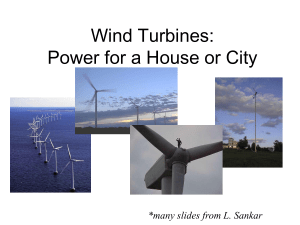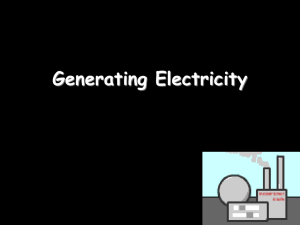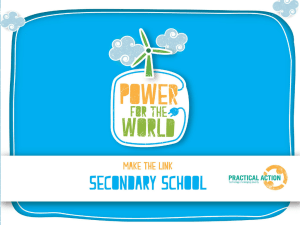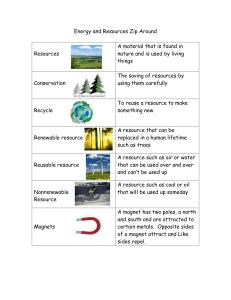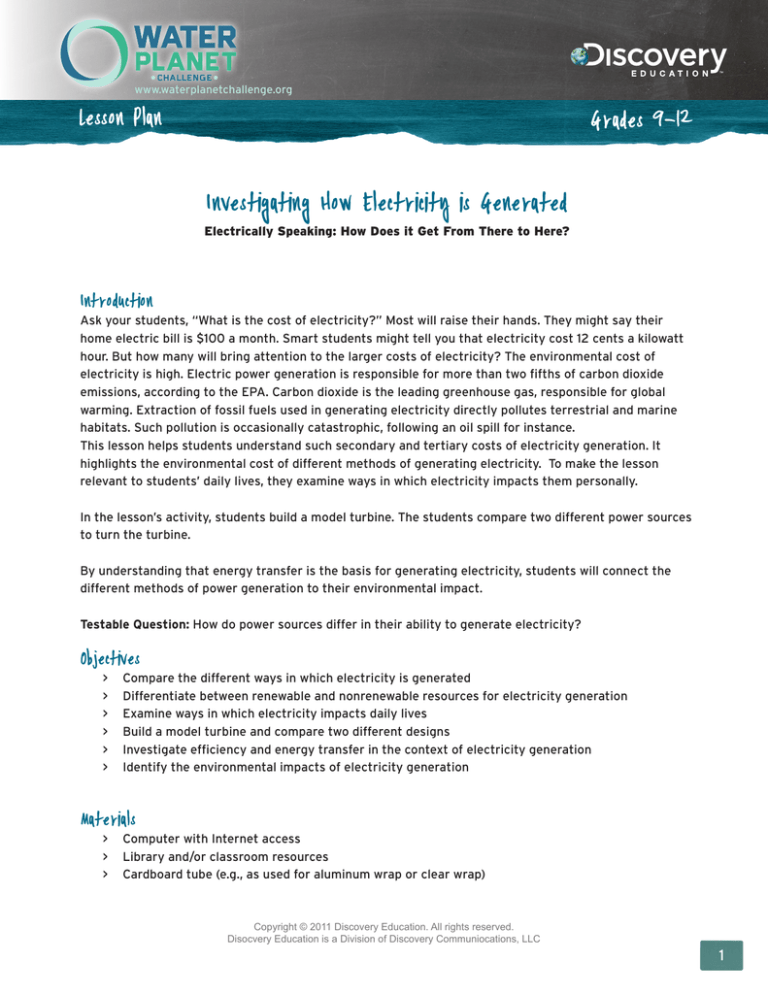
www.waterplanetchallenge.org
Lesson Plan
Grades 9-12
Investigating How Electricity is Generated
Electrically Speaking: How Does it Get From There to Here?
Introduction
Ask your students, “What is the cost of electricity?” Most will raise their hands. They might say their
home electric bill is $100 a month. Smart students might tell you that electricity cost 12 cents a kilowatt
hour. But how many will bring attention to the larger costs of electricity? The environmental cost of
electricity is high. Electric power generation is responsible for more than two fifths of carbon dioxide
emissions, according to the EPA. Carbon dioxide is the leading greenhouse gas, responsible for global
warming. Extraction of fossil fuels used in generating electricity directly pollutes terrestrial and marine
habitats. Such pollution is occasionally catastrophic, following an oil spill for instance.
This lesson helps students understand such secondary and tertiary costs of electricity generation. It
highlights the environmental cost of different methods of generating electricity. To make the lesson
relevant to students’ daily lives, they examine ways in which electricity impacts them personally.
In the lesson’s activity, students build a model turbine. The students compare two different power sources
to turn the turbine.
By understanding that energy transfer is the basis for generating electricity, students will connect the
different methods of power generation to their environmental impact.
Testable Question: How do power sources differ in their ability to generate electricity?
Objectives
>
>
>
>
>
>
Compare the different ways in which electricity is generated
Differentiate between renewable and nonrenewable resources for electricity generation
Examine ways in which electricity impacts daily lives
Build a model turbine and compare two different designs
Investigate efficiency and energy transfer in the context of electricity generation
Identify the environmental impacts of electricity generation
Materials
> Computer with Internet access
> Library and/or classroom resources
> Cardboard tube (e.g., as used for aluminum wrap or clear wrap)
Copyright © 2011 Discovery Education. All rights reserved.
Disocvery Education is a Division of Discovery Communiocations, LLC
1
>
>
>
>
>
>
>
>
>
Cardboard for holder and fins
Cork
Craft knife
Fan
Household fan (3 speed)
Large pins
Marker pen
Plastic or metal strips for fins (optional)
Tape
> CO2 – carbon dioxide, the primary greenhouse gas
> Efficiency – difference between amount of energy put in and energy wasted as heat and is
calculated by the energy output/energy input x 100%
> Electricity – energy available from the flow of charge
> Energy – capacity of a system to do work
> Environment – the habitats surrounding an area
> Fossil fuels – hydrocarbon compounds formed from organic matter
> Generator – device used to convert mechanical energy int electricity
> Heat – energy transferred by a temperature difference
> Natural resources – things that we use provided by the environment
> Non-renewable – natural resources that are not renewed by nature over time
> Renewable – natural resources renewed by nature over time
> Transmission – method to transfer electricity from generator to device
> Turbine – device used to convert kinetic energy into mechanical energy
> Watts – amount of energy used per unit time
Vocabulary
Essential Background for Teacher
This section is need-to-know information for the teacher to teach the lesson effectively.
Key questions:
> Why should we care about how electricity is generated?
> How does electricity impact our daily lives?
> How is electricity generated?
> How does a turbine work?
> What are the different ways electricity is generated?
> What is the benefit of using renewable versus nonrenewable resources to generate electricity?
> How is energy wasted during electricity generation?
> What are the environmental consequences of electricity production?
Key facts:
> Electricity is essential to modern civilization.
> Electricity is measured with several units including: watts for power, amperes for current and volts
for electromotive force of potential.
> We use electricity in numerous ways including: heating and cooling our homes, lighting, laborsaving devices, entertainment, and electric vehicles.
Copyright © 2011 Discovery Education. All rights reserved.
Disocvery Education is a Division of Discovery Communiocations, LLC
2
> Industry and business uses electricity for lighting heating and cooling office buildings, office
equipment, manufacturing and industrial plants.
> When we lose electric power, we lose all of the essential functions it serves.
> Electricity is generated by converting mechanical energy into electrical energy. The mechanical
energy turns coils inside a generator. The coils are located next to magnets. The turning induces
current that is then transmitted to end users or storage.
> A turbine works by converting various sources of kinetic energy into mechanical energy. A
generator converts mechanical energy (usually rotational) to electrical energy.
> More than 90 per cent of our electricity is produced using nonrenewable resources. More than
three-quarters of our electricity is produced using fossil fuels. Nonrenewable resources will
run out, so using them to generate electricity is not sustainable. If we do not switch away from
nonrenewable resources our present way of life cannot be continued. Any measure to improve
efficiency will lessen demand on nonrenewable resources and help sustain our way of life.
> Most nonrenewable resources consume large amounts of energy for extraction, refinement and
transportation. Uranium for nuclear fuel is first hard rock mined and then requires significant
energy for processing, transportation. Redundant engineering is in place for safety at all sites
involved with the handling nuclear fuel. Mountain top removal for the mining of coal degrades
terrestrial and aquatic ecosystems. Oil is transported across oceans and continents before we can
use it to generate electricity.
> Use of renewable resources is sustainable since these resources will not run out. By using
renewable resources we can sustain our civilization indefinitely. Renewable resources have
a smaller “carbon footprint” and so contribute less to global warming than fossil fuel-based
nonrenewables.
> Inefficiency in electricity production and transmission arises from due to wasted heat, friction
during generation and resistance during transmission. About a third of the heat energy produced
by burning fossil fuels is converted to electrical energy. Two thirds is wasted as heat. Electricity is
transmitted at high voltages to reduce resistance.
> Mass production of electricity incurs environmental costs including pollution and land degradation.
Fossil fuel plants pollute the atmosphere with carbon dioxide, which contributes to global
warming, and sulfur dioxide, which causes acid rain. Nuclear power generation creates radioactive
waste that needs special handling procedures and fortified storage facilities. Extraction of fossil
and nuclear fuels also incurs a substantial environmental cost through pollution risk and land
degradation. Health problems occur downwind of oil refineries, nuclear processing plants and coal
fired power plants. The environmental impact of renewable sources of energy is much lower.
> Electricity production can impact on marine ecosystems in several ways. Greenhouse gases
emitted by the combustion of fossil fuels impact the marine environment in two significant ways.
First, CO2, SO2 and NOx gases mix with water to make acids. The resulting acid rain and acid
runoff can damage fragile ecosystems such as coral reefs. At the poles, CO2 mixed into the water
during winter storms also causing acidification. It can cause imbalances in water chemistry of
lakes and oceans. The second effect of the addition of greenhouse to the atmosphere is the
warming of the atmosphere which in turn warms the oceans causing bleaching of corals and dead
zones. Oil spills can devastate marine ecosystems and cause long-term damage to shoreline
habitats. Discharge of warm water (a byproduct of cooling systems) can disrupt the ecology
around a power station. Although renewable resources are desirable, there is little research on the
environmental impact of large tide or wave power installations.
Copyright © 2011 Discovery Education. All rights reserved.
Disocvery Education is a Division of Discovery Communiocations, LLC
3
General Background for Teacher
How we generate electricity
Most power generating systems involve using turbines to convert mechanical energy into electrical
energy. Any moving medium can drive these turbines. The commonest is steam. Steam is produced by
heating water. Fossil fuels are the primary way to produce such heat. Coal plants produce the majority of
electricity in the United States. Nuclear, geothermal and biomass energy are other ways water is heated
to produce steam to power turbines.
Of these, only biomass and geothermal energy are renewable resources. Fossil and nuclear fuels are
nonrenewable. Some nonrenewable resources will run out in the next century or even sooner. Given the
dependence of society on electricity, we must ensure that electrical power generation is sustainable. In
addition, nonrenewables incur a heavy environmental cost. Fossil fuels produce CO2, the gas principally
responsible for global warming. Fossil fuels include coal, natural gas, and petroleum or crude oil. Burning
fossil fuels also creates sulfur dioxide, which reacts with atmospheric water to form sulfuric acid. The
resulting acid rain damages habitat and disrupts water chemistry of natural aquatic systems. Fossil fuel
extraction is a source of pollution in sensitive marine and terrestrial environments. Although nuclear
power does not produce CO2, disposal of nuclear waste requires substantial resources. It continues to be
an environmental and security risk for many decades afterwards.
While not perfect, renewable energy has a much smaller environmental footprint. Solar power is the
only method that does not use turbines. Solar cells directly convert light energy to electricity. They are
reliable and efficient. The drawback is that they are expensive. Their deployment requires considerable
land area. In urban areas, they can be used on new or existing roofs of buildings. There are many exciting
advances being made to increase efficiency and reduce the costs of solar cells. A variety of methods are
used to tap geothermal energy. The commonest is to tap into steam from water heated deep underground.
This is used to turn turbines. The drawback of geothermal is the lack of suitable sites. Biomass creates
methane gas that is burned to create steam and power turbines. Several initiatives are underway to tap
into the methane created in landfills. Biomass derivatives (such as alcohol) can be burned to create heat.
The problem is to get sufficient biomass to create enough gas for commercial electricity generation. Wind
power turns fans that directly turn turbines. Opponents argue that wind farms are an eyesore. Large
areas are needed to generate electricity on a commercial scale. Sites are limited to areas where wind
blows reliably. Solar, wind and hydroelectric are the only methods that do not use steam to turn turbines.
Hydroelectric power relies on dams that store water. When the water is released, it drives turbines.
Hydroelectric power necessitates the flooding of natural areas and can disrupt river ecology downstream.
How is electricity transmitted?
The diagram below shows how electricity generated at a power plant is transmitted to the enduser. In
the United States commercial power stations transmit electricity into a national power grid. Visualize it
as a net covering the country. Regional electric companies manage the distribution of electric power. At
substations, transformers step down the voltage to a usable form, and businesses and homes can use the
electricity.
Copyright © 2011 Discovery Education. All rights reserved.
Disocvery Education is a Division of Discovery Communiocations, LLC
4
http://en.wikipedia.org/wiki/File:Electricity_grid_simple-_North_America.svg
http://en.wikipedia.org/wiki/File:UnitedStatesPowerGrid.jpg
How does a generator work?
A generator is a device that converts mechanical energy into electrical energy. The process is based on
the relationship between magnetism and electricity. In 1831, scientist Michael Faraday discovered that
when a magnet is moved inside a coil of wire, electrical current flows in the wire. A typical generator at
a power plant uses an electromagnet — a magnet produced by electricity — not a traditional magnet. The
generator has a series of insulated coils of wire that form a stationary cylinder. This cylinder surrounds a
rotary electromagnetic shaft. When the electromagnetic shaft rotates, it induces a small electric current
in each section of the wire coil. Each section of the wire becomes a small, separate electric conductor.
The small currents of individual sections are added together to form one large current. This current is the
electric power that is transmitted from the power company to the consumer.
Source: http://www.eia.doe.gov/kids/energy.cfm?page=electricity_science-basics
Copyright © 2011 Discovery Education. All rights reserved.
Disocvery Education is a Division of Discovery Communiocations, LLC
5
Engage
1. Introduce students to the key concepts. (See Vocabulary.)
2. Ask students: Have you ever experienced a power outage or black out? What happened? How did you
feel? Was it inconvenient? What did you miss the most during the power outage? How long did it last?
What caused the outage? Was it widespread?
3. Ask students: What happens elsewhere during a blackout? (Prompt students with additional questions.
What happens at the shopping mall? What happens to traffic? What happens at hospitals?) The aim is to
get them to realize how much society depends on electricity.
4. Ask students: Investigate real time power outages at this website. http://progress-energy.com/shared/
outages/car/default.aspx How many power outages are there? How is this information useful to the
power company?
5. Ask students: Compare the two photographs below. They are satellite images of the biggest blackout
in U.S. history. It occurred on August 14, 2003, leaving 50 million people without power. The first is 20
hours before the black out and the second is 7 hours after the initial blackout started. (Prompt them to
observe which cities were most affected. Lights in Long Island, Detroit, Cleveland, Columbus, Toronto,
and Ottawa are either missing or visibly reduced. Boston was relatively unaffected.
http://visibleearth.nasa.gov/view_rec.php?id=18796
6. Ask students: How does electricity get to your house or school? What is the point of origin for the
transmission of the power? How is it transmitted? Where are the places an interruption of service could
occur?
7. Prompt students with additional questions. How is electricity supplied to so many homes and
businesses? Where does electricity come from? Do you have electricity transmission lines near your
house?
8. How is electricity for your area generated? Is electricity generated the same way all across the
country? What are some other ways to generate electricity and where in the country do you think these
methods are most in use?
Copyright © 2011 Discovery Education. All rights reserved.
Disocvery Education is a Division of Discovery Communiocations, LLC
6
Lesson Lead-in
1. Explain that electricity is generated when a coil turns inside a magnet. This rotation is the basis for
generating power on a large scale.
2. Explain that millions of homes and business, and large industrial and manufacturing plants are powered
by electricity. We need big power plants to generate enough electricity to meet those needs.
3. To generate electricity, a turbine turns a generator. There are various ways this can be achieved. Explain
that fossil and nuclear fuels heat water to create steam. In turn the steam turns the turbine.
4. Ask students: what other ways, besides steam, power stations could turn a giant turbine? (Prompt them
with the following images:
http://www.fws.gov/digitalmedia/cdm4/item_viewer.php?CISOROOT=/natdiglib&CISOPTR=6861
http://apps1.eere.energy.gov/news/images//08_03_12_hoover_dam.jpg
5. Explain that they are going to build a turbine. This will demonstrate the principle for using mechanical
energy to turn generators. .
Explain (Sample Answers to Analysis Questions)
Use these answers to help explain the concepts and ideas behind the lab activity (Analysis in the Student
Resource Section).
1. What is the difference in your turbine RPMs between the slowest and fastest fan speeds with the
cardboard fins design?
Answers will vary.
2. What is the difference in your turbine RPMs between the slowest and fastest fan speeds with the plastic
fins design?
Answers will vary.
Copyright © 2011 Discovery Education. All rights reserved.
Disocvery Education is a Division of Discovery Communiocations, LLC
7
3. Was your plastic design an improvement on the cardboard? Explain.
Answers will vary. Sample answer: For the wind data, the two designs were comparable. Using water, the
plastic was an improvement, since RPMs were higher at the same water speed.
4. In what ways could you improve further on your design?
Sample answer: Various approaches could be taken. A more solid framework would decrease movement
of the cardboard holder. This would increase the efficiency of energy being transferred to the turning
part of the turbine. We could use better axle material to reduce friction of turning. We could experiment
with the angle and shape of the fins.
5. You used wind and water to turn the turbine. What other ways could you use to turn the turbine? Sample
answer: The turbine could be turned with steam blowing from a kettle.
6. Compare the RPMs using the faucet with the RPMs using the fan. Are they faster or slower? Is it fair to
compare the speeds? How does wind compare with water as a medium for turning the turbine?
Answers will vary. Sample answer: The RPMs were slower with the faucet compared with the fan. The
turbine speed is influenced by the speed of the medium. Since water tends to flow more slowly than
wind blows, the wind will usually turn the turbine faster. However, since water is more dense, it carries
more energy per unit volume. Therefore, water should be able to turn much larger turbines than wind.
7. How would you generate electricity with your turbine?
Answers will vary. Sample answer: To generate electricity we would have to rig a generator to the
turbine. The turbine would rotate the generator and generate electricity.
Elaborate or extend
1. Ask students: Examine the sample electric bill. Why do we have to pay for electricity? What is a kWh?
Why do you think there are charges for transmission, energy conservation and renewable energy?
2. Ask students: Are there ways to reduce your electric bill? What are the economic and environmental
benefits of a lower electric bill?
3. Ask students: If we lower our electric bill by using less electricity, how will that change the need for new
or bigger power stations?
4. Ask students: Research resources used for electrical power generation using the websites provided.
(Split the class into separate groups to research different types of power generation. Each group
is responsible for reporting to the class the economic, environmental and political advantages and
disadvantages of using different power sources: oil, coal, natural gas, nuclear, wind, hydroelectric,
wave or tide, geothermal.) The total cost of the production of electricity needs to be considered from
procurement and extraction of the resources used to the disposal of any waste products.
5. Ask students: If we can use less electricity, what kinds of resources can we use to meet our needs for
electric power?
6. Ask students: Compare following maps for distribution of renewable energy resources. Where are the
most resources for a particular type of energy? Is it possible to meet all our national needs from one
energy source? How might a mix of resources meet our energy needs?
Copyright © 2011 Discovery Education. All rights reserved.
Disocvery Education is a Division of Discovery Communiocations, LLC
8
http://www.energysavers.gov/images/biomass_map.gif
http://tonto.eia.doe.gov/energyexplained/images/charts/map_pv_national-large.gif
United States Wind Resources: http://www.neo.ne.gov/reports/accel_wind.htm#_Toc445891755
Copyright © 2011 Discovery Education. All rights reserved.
Disocvery Education is a Division of Discovery Communiocations, LLC
9
Evaluate
Discuss and write answers to the following questions (Use citations where appropriate) :
1. How much did your turbine performance improve between the cardboard versus plastic fin designs?
Include data to support your answer.
2. In what ways might turbine design be important for efficient generation of electricity?
3. What might go wrong in the steps to get electricity from the power station to your home?
4. What steps can you take at home to increase efficiency of energy use?
5. What are the advantages and disadvantages of using renewable and nonrenewable resources for
electricity generation? Consider economic, environmental and political implications in your answer.
6. What are three environmental impacts of using fossil fuels for electricity generation?
http://www.mass.gov/Eoca/images/doer/bill.gif
Copyright © 2011 Discovery Education. All rights reserved.
Disocvery Education is a Division of Discovery Communiocations, LLC
10
I. National Standards
B. ESS Core Idea 4: Human activities are constrained by and, in turn, affect all other processes at Earth’s
surface. [Human Interactions with Earth] Grade 9-12
Sub-question: How will global climate change affect humans?
Climate change, driven by both natural and human activities, has large consequences for all of Earth’s
surface systems, including humans. Humans can take actions to reduce climate change and its impacts.
PS Core Idea 3: Transfers of energy within and between systems never change the total amount of energy,
but energy tends to become more dispersed; energy availability regulates what can occur in any process.
[Energy and its Transformations]
Where do we get energy?
Electric power generation uses fossil fuels (coal, oil and natural gas), nuclear fission, or renewable resources
(solar, wind, tidal, geothermal and hydro- power).
Transportation today chiefly uses fossil fuels but electric and alternate fuel (hydrogen, biofuels) vehicles are a
growing sector.
All forms of electrical generation and transportation fuels have associated economic, human, and
environmental costs and risks, both short and long term. Technological developments and regulatory decisions
can change the balance of these factors.
What is energy efficiency?
While energy cannot be destroyed, it can be converted to less useful forms, such as noise and thermal
energy lost to the surrounding environment. In designing any machine or any system for energy storage
and distribution, maximized efficiency means maximized desired impact per input fuel. Efficiency is a major
element to optimize because it reduces costs, waste materials and other environmental impacts.
Copyright © 2011 Discovery Education. All rights reserved.
Disocvery Education is a Division of Discovery Communiocations, LLC
11
www.waterplanetchallenge.org
Student Resource page
Explore: Hands On Activity – Build a turbine
Commercial electricity production relies on the turning of a turbine, which turns a generator to create electrical
current. The design of a turbine influences how effectively it transfers the kinetic energy of a moving medium
to rotational mechanical energy. In this lab you will build and compare your own designs of model turbine.
Materials:
>
>
>
>
>
Cardboard tube (e.g., as used for aluminum wrap
or clear wrap)
Cardboard for holder and fins
Plastic acetate strips (1 or 2mm thick)
Cork
Craft knife
>
>
>
>
>
>
Faucet
Household fan (3 speed)
Large pins
Marker pen
Tape
Timer
http://www.energyquest.ca.gov/projects/waterenergy.html
Procedures:
1. Use the picture below as a guide to how to build your turbine.
2. Push a pin in the ends of the cork to act as axles.
3. Make a U-shaped cardboard holder for it.
4. Use the craft knife to cut slits into the cork.
5. Cut pieces of card to act as fins for the turbine.
6. Place the card the slits made in the cork.
7. Color one of the fins with the marker pen.
8. Place the cork into the holder.
9. Tape the holder to a table or similar surface.
10.Use the fan on the slowest speed setting to create wind to blow at your turbine.
Copyright © 2011 Discovery Education. All rights reserved.
Disocvery Education is a Division of Discovery Communiocations, LLC
12
www.waterplanetchallenge.org
Student Resource page (Continued)
Explore: Hands On Activity – Build a turbine
11. Use the timer to count how many times the colored fin makes a complete turn in one minute. (This is the
revolutions per minute, or RPM of your turbine.) Record your data in the worksheet.
12. Repeat steps 9 and 10 using the two additional speeds of the fan.
13. Using a new cork, repeat steps 4 through 11 using the plastic acetate as fins.
14.Set the faucet running at a constant but gentle speed.
15. Place the turbine with cardboard fins under the flowing water. Repeat Step 11.
16.Place the turbine with plastic fins under the flowing water. Repeat Step 11.
Analysis:
1. What is the difference in your turbine RPMs between the slowest and fastest fan speeds with the
cardboard fins design?
2. What is the difference in your turbine RPMs between the slowest and fastest fan speeds with the plastic
fins design?
3. Was your plastic design an improvement on the cardboard? Explain.
4. In what ways could you improve further on your design?
5. You used wind and water to turn the turbine. What other ways could you use to turn the turbine?
6. Compare the RPMs using the faucet with the RPMs using the fan. Are they faster or slower? Is it fair
to compare the speeds? How does wind compare with water as a medium for turning the turbine?
Describe how this explains the difference between the size of water turbines used in hydroelectric dams
compared with turbines in wind generators.
7. How would you generate electricity with your turbine?
Copyright © 2011 Discovery Education. All rights reserved.
Disocvery Education is a Division of Discovery Communiocations, LLC
13
www.waterplanetchallenge.org
Data Collection Student Worksheet
RPMs of turbine designs at different fan speeds and using the fan
Fan Speed
Slowest
Medium
Faucet
Fastest
Cardboard fins
Plastic fins
RPMs of turbine designs at different fan speeds and using the faucet
Water Speed
Slowest
Medium
Faucet
Fastest
Cardboard fins
Plastic fins
Copyright © 2011 Discovery Education. All rights reserved.
Disocvery Education is a Division of Discovery Communiocations, LLC
14

